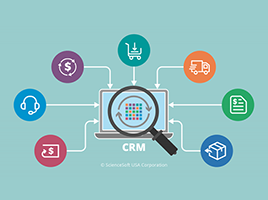Finding a needle in a haystack is hard. You know what’s even harder? Finding a specific needle in a pile of needles.Selecting the ideal Enterprise Resource Planning (ERP) solution from among the numerous options on the market can feel like just as daunting a challenge. ERP is a serious investment for any organization, but it is absolutely vital to success in manufacturing. The ERP selection process should be regarded as a top priority, with appropriate time and resources devoted to it.

Top-performing manufacturers approach the selection process with a clear plan in mind and come away with solutions that implement smoothly and help drive business immediately. Less meticulous organizations become saddled with solutions that are not good fits for their industries, continually disappoint, put additional strain on the organization, and often need to be replaced. In order to get started on this journey, examine the selection criteria that today’s leading manufacturers utilize when selecting an ERP solution. (Figure 1).

Survey takers were asked to indicate their top four selection criteria for ERP. For manufacturers, the top two criteria are functionality and ease of use. Simply put, manufacturers expect their ERP solution to work, and work well. Top performers have detailed plans for what they hope to accomplish with their ERP, but those plans are useless if they select a solution that does not work as expected or lacks necessary features.
For example, are the processes that are necessary for the organization’s success supported in the potential solution? Does the organization need to be able to perform product recalls? Is full financial or field service functionality needed? Top-performing organizations find ERP solutions that run smoothly and deliver as promised. But even the most functional of ERP solutions is a waste of money if employees can’t use it. A user-friendly ERP solution will lead to a higher employee usage rate and the solution’s benefits will more quickly and profoundly manifest themselves throughout an organization. A clean, intuitive interface will decrease user confusion and increase overall productivity.
It may be surprising that total cost of ownership is only the third leading selection criteria. It is wise to care more about the functionality and ease of use of an ERP solution than its impact on your wallet. Nevertheless, ERP does represent a significant investment and manufacturers want to be sure their capital is well spent. When evaluating cost, some organizations may find that certain ERP solutions have features they do not need and are therefore not worth paying for. An organization may not have the resources available to make a large up-front capital investment and would prefer to pay on a month-to-month basis for a Software as a Service (SaaS) ERP solution. Weigh the costs against what you’re getting to determine if your choice is good.
Next, since the entire purpose of an ERP solution is to contain all of the essential data for running a business, many manufacturers are interested in ERP solutions that are integrated suites. This preference for a set of programs and applications that work together seamlessly has numerous benefits. Employees are better able to find the data they need to make decisions and are better able to seek out and find that data on their own. Decision makers can use an integrated suite as a one-stop-shop for actionable data that also serves as the organization’s system of record. Of course, there may be some existing technologies that a manufacturer would choose to hold on to. In these cases, ERP needs to provide integration capabilities in order to retain the feeling of a centralized source.
There is further concern about the ability to change or augment ERP. ERP is not “one size fits all.” In the current manufacturing environment, organizations may anticipate their business evolving, creating the need for an ERP system to evolve along with it. As organizations add processes, products, or business units, their ERP system must be able to reflect those changes to the business quickly, cheaply, and without disruption. It is important to ensure that the ERP system can scale and change with the business.
Lastly, manufacturers have prioritized industry-specific ERP solutions more so than any other industries. After all, the needs of a food and beverage manufacturer are very different from an industrial equipment manufacturer. Therefore, top-performing manufacturers are 46% more likely to ensure that their ERP solution is aligned with business objectives. These organizations view ERP systems properly — not as a blanket solution to all their problems, but as a tool to help them reach their goals. With business objectives clearly in mind, organizations can find the appropriate functionality and features among the myriad of ERP solution options.

Further, 48% of Leaders have industry-specific best practices contained within their ERP solution. Some processes, such as the ability to do a product recall based on batch information, are just not necessary in some organizations. These organizations get the tailored functionality they need while avoiding features that are unnecessary for their line of business. Looking for an industry-specific solution will also help narrow the wide field of ERP choices and provide a solution that is the best fit. This is a new way to ensure that the processes your organization uses match the best practices of your competitors.
The ERP selection process need not be intimidating for those organizations with the right mindset. Organizations looking for a smooth and successful ERP selection process should take the following steps:
- Develop a clear plan prior to selection. This helps them know exactly what you are looking for as you enter the market and gives them a roadmap to follow once you begin implementation. Ensure that you define your needs and create your selection criteria accordingly.
- Value functionality and ease of use over cost. Manufacturers look at functionality and ease of use before they consider cost, as saving money on ERP is a moot effort if the solution fails to work as needed. Spending a little extra on a successful ERP solution will save much more down the road than living with a cheaper but disappointing solution.
- Get input from all levels of the organization. Those that get the most value out of ERP consider the needs of the line of business when making an ERP selection. Utilizing cross-functional teams will also ensure that all voices within the organization are heard and ERP serves every department’s needs.
- Align ERP with your goals and industry. Manufacturers can set up their ERP solution for success if they know exactly what they hope to accomplish with it. It is easier to find the right solution when ERP is viewed as a tool to achieve a business objective. All organizations can also benefit from solutions designed specifically for their respective industries that offer ideal functionality and features.
By following these steps, manufacturers can find an ERP solution that will meet all their demands and propel them to sustained success.
by Nick Castellina




